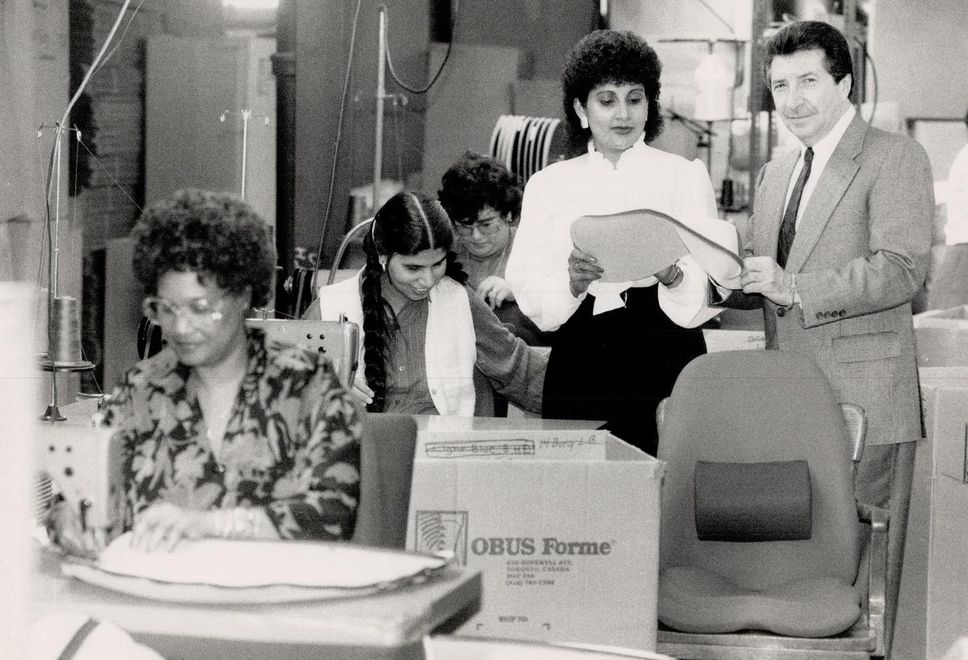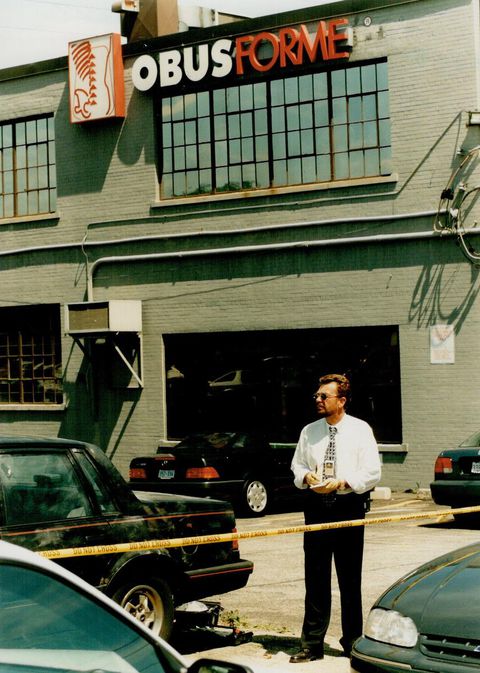The hit man was waiting in the west Toronto parking lot when CEO Frank Roberts pulled up to his OBUS Forme Ltd. factory and stepped out of his black Mercedes SL 500 convertible.
There were two point-blank bullets to the chest and one to the head.
The gunman fled the scene as employees continued to arrive on Aug. 13, 1998, at the factory Roberts had built on Hopewell Avenue at Dufferin Street.
Police got the call at 7:24 am and were there within minutes but the killer was already long gone, driven away by another member of the hit team.
Workers sobbed in disbelief at the sight of their diminutive boss lying on the pavement.
Many of the company’s 150 employees were new immigrants to Canada and Roberts had given them a chance at a better life while treating them with dignity.
“He had no enemies. So who?” receptionist Angie Maharaj asked reporters.
“He was the best,” Maharaj said.
There was something surreal about the scene, as police officers photographed and measured the crime scene and dozens of bouquets of flowers were left at the factory front door: High-profile Canadian CEOs aren’t often shot dead in mob-style executions.
Until the instant he was shot, Roberts seemed capable of talking his way out of or into anything.
He was also a hard man to figure out.
There was the successful side: his corporation sold back-supports throughout the United States, Canada and a reported 26 other countries.
OBUS Forme had been honored as one of Canada’s 50 Best-Managed Private Companies and Roberts was named one of Canada’s “Top 100 Entrepreneurs.”
Those honors were real, but plenty of material on Roberts’ resume was phoney.
Who’s Who listings indicated two different — and prestigious — university educations for Roberts: Yale University and the University of Connecticut.
But when contacted by the Star, neither university could find any trace of Roberts.
Roberts claimed to be a member of the Ontario Association of Certified Engineers. The Star could not find evidence of that association ever existing.
Roberts also claimed to have written a book on marriage, although a search by the Star could not confirm the existence of any book ever written by him.
The grandfather of 13 children also said he only needed two hours of sleep a night, but still had enough energy to earn a black belt in karate and to run marathons. Shortly before his death, he announced he had taken up training for boxing and would soon have his first match.
Ray Zarb, a former Toronto homicide detective who worked on the case for years, laughed in an interview at the thought of Roberts as a pugilist.
Zarb now works as a private investigator and for a crime analytics company based in the United Kingdom.
The deeper Zarb and other detectives dug under the veneer of Robert’s back story, the more complex the real-life narrative seemed.
While Roberts was beloved by many of his employees, police developed a list of people who wanted him dead, Zarb said.
Zarb said he learned that there had been an earlier plot by a GTA organized crime group to have Roberts murdered that wasn’t carried out when a prospective hit man backed out of the job.
The would-be hit man said, “I can’t do this. I can’t pull the trigger on this” and gave back the gun, Zarb said.
Then another shooter and another driver were given the job, Zarb said.
“Organized crime was definitely involved because there’s money involved,” he said.
Roberts “was in the way of the company going a certain direction,” Zarb said. “He was quite content with making his million-plus a year. He did n’t want anyone else meddling in his business from him.”
Roberts was murdered at a time when big changes were underway in his business and personal life.
The patent was running out on his signature product.
Roberts, who was thrice-divorced, had also recently started dating — and showering gifts — on Etty Sorrentino, 31, a married Florida woman less than half his age.
Roberts was a wealthy man, but even rich men can feel the pinch when buying a lover a new home, Mercedes and plenty of other posh gifts.
Etty Sorrentino and her husband both had solid alibis: At the time of Roberts’ murder, they were on vacation together in Italy.
Zarb doesn’t think she or her husband was behind the murder — “no, no, no,” he said.
Investigators learned that success came relatively late in life for Roberts, who had earlier made a living alternately building luxury homes, importing furniture and running a gift shop.
Then, as the story went, he re-injured his chronic bad back while playing tennis with his daughter.
That sent him to hospital, where he was outfitted in a plaster body cast.
While bed-bound, the idea hit him: why didn’t he manufacture something like his hospital cast for others with bad backs? And why not make it light and portable, so it could fit into most chairs?
He called his invention “Obus Forme,” French for “shell-shaped.”
Soon, he was giving customized models to comedians Carl Reiner and Mel Brooks and action movie star Jackie Chan.
His product was sometimes mentioned during Blue Jays’ baseball broadcasts — radio announcer Jerry Howarth, a back pain sufferer, was another public Obus Forme user.
Shortly before his murder, Roberts threw out the opening pitch at a Jays game.
Zarb says he’s convinced he knows who pulled the trigger and drove the getaway car on the morning of Thursday, Aug. 13, 1998.
“I know who did it,” said Zarb, who investigated the killing twice — first as a fresh murder and next as a member of the Toronto police cold case homicide squad.
Zarb won’t give the names of the people he thinks were on the hit team or the precise motive for the killing.
He said the evidence gathered by detectives wasn’t considered strong enough for prosecutors to take to court — a decision he disputes.
“There’s that one case that every detective has that bugs them the rest of their life,” Zarb said.
“Does it hurt?” Zarb said. “It does. There’s no closure. Not just for me but the family and the loved ones of Frank.”
Zarb said he can’t stop thinking about the case, even after his retirement from the force.
“There’s someone out there who has committed murder,” he said.
JOIN THE CONVERSATION

